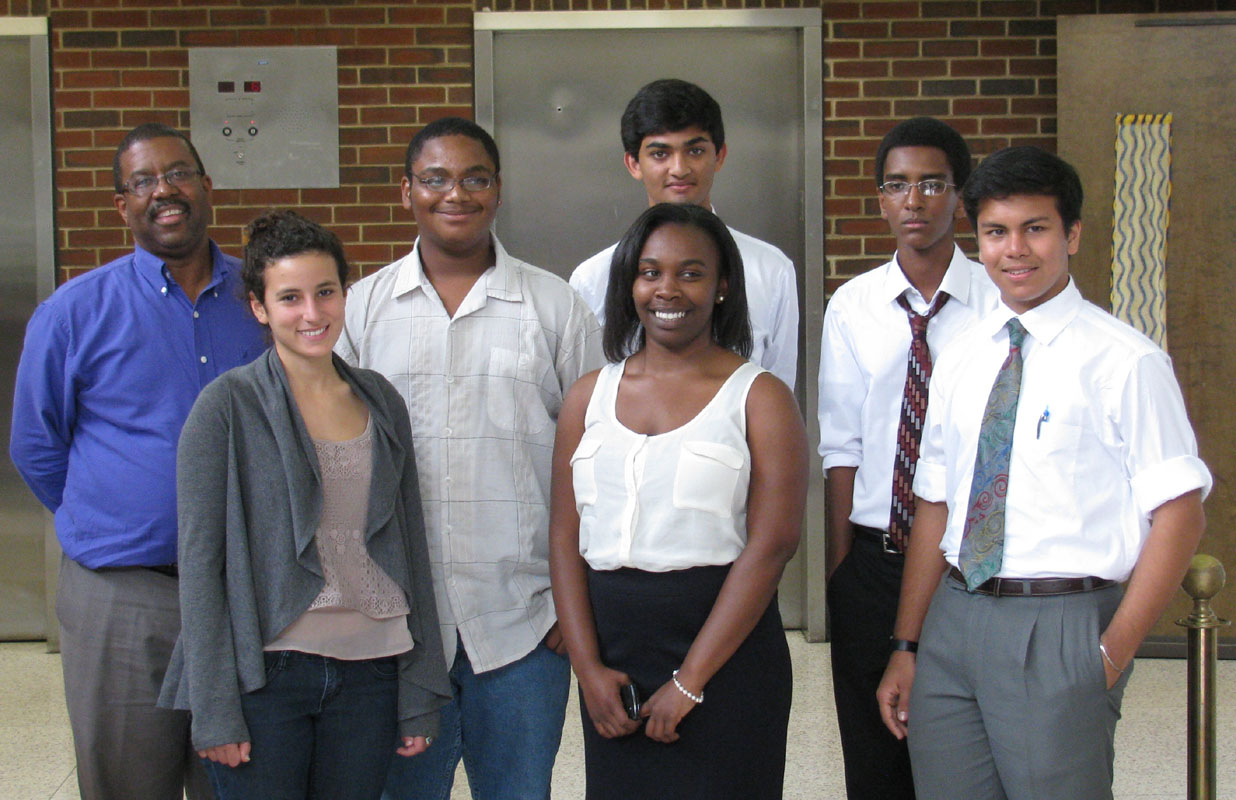
NCA&T Photo: From left: Faculty advisor Vernal Alford and Young Scholars Shira Chandler, Dondre McCaskill, Brianna Hargett, Aditya Badve, Ephraim Bililign and Aditya Garg
GREENSBORO, N.C. - If you ask Greensboro high school student Brianna Hargett what she did over the summer, you won’t get a typical answer. She’ll tell you about her research in automatic imaging analysis of biomaterials.
Ms. Hargett and five fellow students from local high schools didn’t have ordinary summers. They spent six weeks as hands-on bioengineering researchers at the Engineering Research Center (ERC) at North Carolina Agricultural and Technical State University.
As participants in the ERC’s Young Scholars program, they worked on the center’s core projects alongside N.C. A&T professors and graduate students, as well as eight local high school and community college teachers and nine undergraduates from universities around the nation. (Details on their research teams and projects are below.)
Shira Chandler and Dondre McCaskill worked on the design and analysis of biodegradable magnesium screws to reconstruct knee ligaments.
For Ephraim Bililign, it was design and testing of biomedical materials, and Aditya Garg worked on corrosion testing of magnesium alloys. Aditya Badve was part of a team working on how to improve those studies.
They’re all excellent students, but when ERC researchers talk about them, another word that keeps coming up is “driven.”
“It’s big stuff that they’re working on, but they love it because they’re hanging with the big guys,” says Dr. Jagannathan Sankar, ERC director and professor of mechanical engineering.
The ERC is mandated by its funder, the National Science Foundation, to provide exposure to its new technology to high school students and teachers and to undergraduates from other universities.
That outreach work is educational, but it isn’t separate from the research.
“The young scholars, when they came in, had expectations of doing busywork, but within a week or two they realized that they were really contributing to the research enterprise,” said Dr. Devdas Pai, ERC outreach director and professor of mechanical engineering.
By selecting accomplished teachers and high-achieving students, the center brings in a group that contributes to its research even while learning about both the technology itself and the practical aspects of being science and engineering researchers.
In addition to learning bioengineering, the students and teachers also received professional-development training, inside and outside the lab. They learned first-hand how to work as research scientists – the challenges, standards, and expectations. “People don’t know the amount of effort and stress that goes into this,” Sankar says.
The Young Scholars, teachers and undergraduates also attended weekly seminars with the year-round ERC researchers, covering such topics as research ethics, bioethics, and entrepreneurship in addition to technical subjects. For researchers today, simply knowing science isn’t enough.
“Each project is like a small business,” Sankar says. “You have a budget. You have competitors; who is patenting, what industries are interested?”
There also were visits to other research labs, such as ERC partner OrthoKinetic Technologies in Southport and the North Carolina Research Campus in Kannapolis. In addition, special enrichment programs included training for the teachers in creating classroom teaching modules and instruction for the students in writing resumes.
The ERC is more properly known as the National Science Foundation Engineering Research Center for Revolutionizing Metallic Biomaterials. Its goal is to develop biocompatible, magnesium-based materials for surgical implants to be used in orthopedic, craniofacial and cardiovascular operations. Once the patient’s body has recovered to the extent it no longer needs the implant, removal surgery will be avoided as the implant is signaled to degrade and pass out of the body.
Originally a five-year, $18 million project awarded in 2008, the ERC’s success has earned an extension of at least three years and $12 million.
That means for at least three more summers, top local high school students and teachers will learn first-hand what advanced bioengineering research is all about. More K-12 and community college teachers will then bring their new knowledge of science and technology into their classrooms. And more high school students will take some big steps toward joining the next generation of scientists and engineers.
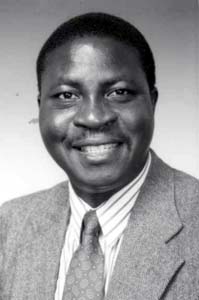 SHOFOLUWE
PRESENTS AT INTERNATIONAL CONFERENCE
SHOFOLUWE
PRESENTS AT INTERNATIONAL CONFERENCE Mug: Dr. Musibau Shofoluwe
GREENSBORO, N.C. - Dr. Musibau Shofoluwe, an assistant professor in the School of Technology at North Carolina A&T State University, was a lead presenter at the 2012 International Conference on Sustainable Development and Environmental Protection held recently in Nigeria. The conference was jointly sponsored by the Institute for Environment Research and Development and Bells University of Technology, Ota, Nigeria. His peer-reviewed paper was titled “The Need for Environmental Citizenship Education and Awareness in Nigeria.”
Shofoluwe also co-authored a peer-reviewed article with other colleagues in the School of Technology, Dr. .Andrea Ofori-Boadu, instructor, Dr. Lewis Waller, associate professor, and Dr. Christian Bock Hyeng, assistant. The article titled “Quality Improvement Practices of Award-Wining Residential Builders and Housing Developers” appears in the International Journal of Industrial Engineering & production Research (March 2012, Vol. 23, No. 1).
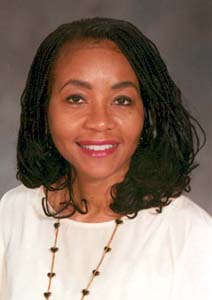 Callahan
Served as Panelist at National Journalism Educator Conference
Callahan
Served as Panelist at National Journalism Educator Conference
Mug: Dr. Linda Florence Callahan
GREENSBORO, N.C. - Dr. Linda Florence Callahan, a professor in the
journalism and mass communication department , served as a panelist at
the 100th Annual Association for Education in Journalism and Mass
Communication Conference in Chicago in August. The session-title was
“From Media Professional to Professor: Should Professionals of Color
Make the Switch? Benefits and Consequences.” Callahan, former AEJMC
board member and immediate past chair of the Commission on the Status of
Minorities, currently serves on the AEJMC Diversity Task on Recruiting
for Academic Diversity.
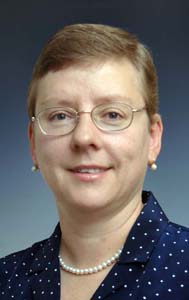 A&T
BUSINESS PROFESSOR PUBLISHES PAPER
A&T
BUSINESS PROFESSOR PUBLISHES PAPER Mug: Dr. Luba Kurkalova
GREENSBORO, N.C. – Dr. Luba Kurkalova, an associate professor in the department of economics, School of Business and Economics, and with the department of energy and environmental systems, College of Arts and Sciences at North Carolina A&T State University, and David Archer, USDA-ARS, have published a paper, “Economic outcomes of greenhouse gas mitigation options,” in Managing Agricultural Greenhouse Gases (M. Libig, A. Franluebbers, and R. Follett (EDs), Elsevier, 2012).
In addition, Kurkalova and Dr. Tara Wade, post-doctoral research associate in the N.C. A&T Department of Economics, presented a paper “Using Logit model with aggregated choice data in estimation of Iowa corn farmers’ conservation tillage subsidies,” at the Agricultural and Applied Economics Association annual meeting in Seattle.
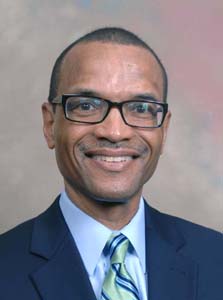 A&T
ACCOUNTING PROFESSOR HONORED AT NABA NATIONAL CONVENTION
A&T
ACCOUNTING PROFESSOR HONORED AT NABA NATIONAL CONVENTION Mug: Dr. Ronald Campbell
GREENSBORO, N.C. - Dr. Ronald Campbell, an assistant professor of accounting in the School of Business and Economics at North Carolina A&T State University, was honored during the National Association of Black Accountants (NABA) Inc. National Convention and Expo that was recently held in Phoenix, Ariz., where he received the National Achievement in Education Award. Campbell has served as the faculty advisor for the NABA student chapter at N.C. A&T since 2000.
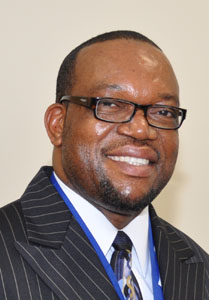 Uzochukwu
Publishes Global Warming Paper
Uzochukwu
Publishes Global Warming Paper Mug: Dr. Godfrey Uzochukwu
GREENSBORO, N.C. - Dr. Godfrey A. Uzochukwu, director of the Interdisciplinary Waste Management Institute at North Carolina A&T State University, has published a paper titled "The Impact of Global Warming on North Carolina" in the Forum on Public Policy, a journal of the Oxford Round Table. Uzochukwu's paper focused on the impact of global warming on North Carolina. He concluded that advancing the knowledge of global warming is important for public health, water resources, recreational activities, and vegetation. He participated in the Oxford Round Table at the Harris Manchester College of the University of Oxford in England.